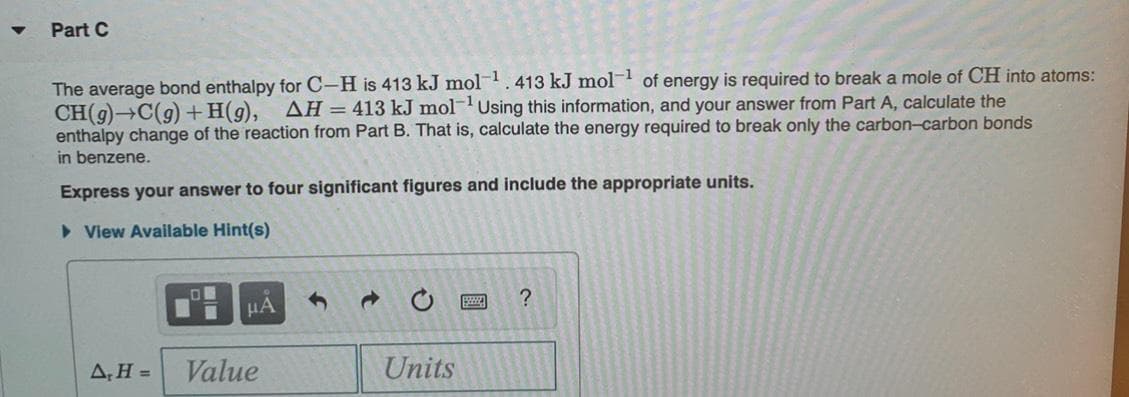The average bond enthalpy for C-H is 413 kJ mol.413 kJ mol- of energy is required to break a mole of CH into atoms: CH(9) C(g) + H(g), AH =413 kJ molUsing this information, and your answer from Part A, calculate the enthalpy change of the reaction from Part B. That is, calculate the energy required to break only the carbon-carbon bonds in benzene. Express your answer to four significant figures and include the appropriate units. > View Available Hint(s) HA AH = Value Units
The average bond enthalpy for C-H is 413 kJ mol.413 kJ mol- of energy is required to break a mole of CH into atoms: CH(9) C(g) + H(g), AH =413 kJ molUsing this information, and your answer from Part A, calculate the enthalpy change of the reaction from Part B. That is, calculate the energy required to break only the carbon-carbon bonds in benzene. Express your answer to four significant figures and include the appropriate units. > View Available Hint(s) HA AH = Value Units
Chemistry: An Atoms First Approach
2nd Edition
ISBN:9781305079243
Author:Steven S. Zumdahl, Susan A. Zumdahl
Publisher:Steven S. Zumdahl, Susan A. Zumdahl
Chapter7: Chemical Energy
Section: Chapter Questions
Problem 126CP: The standard enthalpies of formation for S(g), F(g), SF4(g), and SF6(g) are +278.8, +79.0, 775, and...
Related questions
Question
From part A ∆H°r=5532.1KJ/mol
From part B C6H6(g)->6CH(g)

Transcribed Image Text:Part C
The average bond enthalpy for C-H is 413 kJ mol. 413 kJ mol of energy is required to break a mole of CH into atoms:
CH(9) C(9) + H(9),
enthalpy change of the reaction from Part B. That is, calculate the energy required to break only the carbon-carbon bonds
AH = 413 kJ mol-Using this information, and your answer from Part A, calculate the
in benzene.
Express your answer to four significant figures and include the appropriate units.
• View Available Hint(s)
HA
AH =
Value
Units
Expert Solution
This question has been solved!
Explore an expertly crafted, step-by-step solution for a thorough understanding of key concepts.
This is a popular solution!
Trending now
This is a popular solution!
Step by step
Solved in 2 steps with 1 images

Knowledge Booster
Learn more about
Need a deep-dive on the concept behind this application? Look no further. Learn more about this topic, chemistry and related others by exploring similar questions and additional content below.Recommended textbooks for you

Chemistry: An Atoms First Approach
Chemistry
ISBN:
9781305079243
Author:
Steven S. Zumdahl, Susan A. Zumdahl
Publisher:
Cengage Learning

Chemistry
Chemistry
ISBN:
9781305957404
Author:
Steven S. Zumdahl, Susan A. Zumdahl, Donald J. DeCoste
Publisher:
Cengage Learning


Chemistry: An Atoms First Approach
Chemistry
ISBN:
9781305079243
Author:
Steven S. Zumdahl, Susan A. Zumdahl
Publisher:
Cengage Learning

Chemistry
Chemistry
ISBN:
9781305957404
Author:
Steven S. Zumdahl, Susan A. Zumdahl, Donald J. DeCoste
Publisher:
Cengage Learning


Chemistry: The Molecular Science
Chemistry
ISBN:
9781285199047
Author:
John W. Moore, Conrad L. Stanitski
Publisher:
Cengage Learning

General Chemistry - Standalone book (MindTap Cour…
Chemistry
ISBN:
9781305580343
Author:
Steven D. Gammon, Ebbing, Darrell Ebbing, Steven D., Darrell; Gammon, Darrell Ebbing; Steven D. Gammon, Darrell D.; Gammon, Ebbing; Steven D. Gammon; Darrell
Publisher:
Cengage Learning

Introductory Chemistry: A Foundation
Chemistry
ISBN:
9781337399425
Author:
Steven S. Zumdahl, Donald J. DeCoste
Publisher:
Cengage Learning